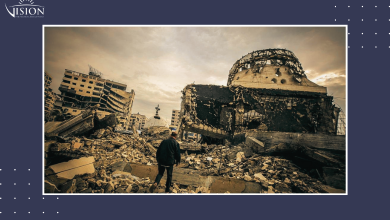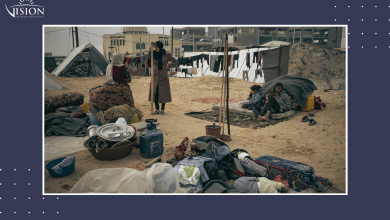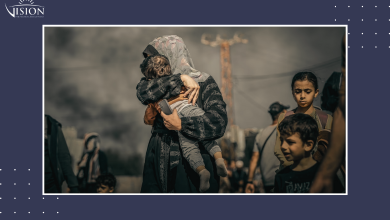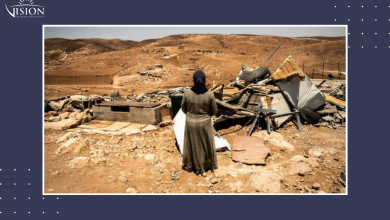Deferred Justice: Palestine Between the Collapse of International Authority and Washington’s Hegemony
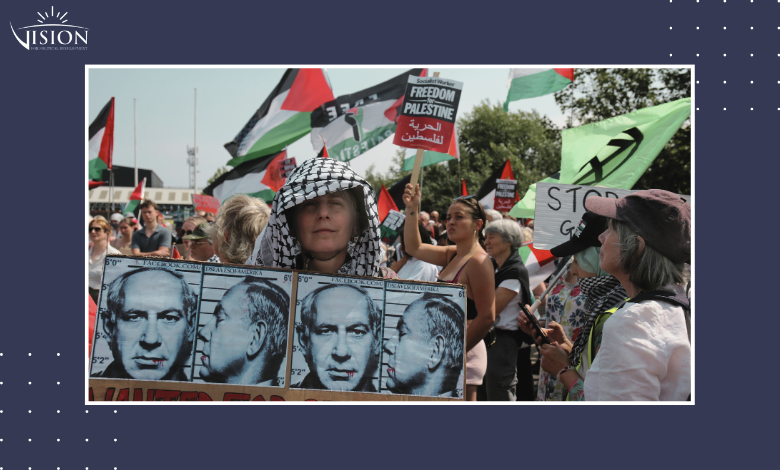
Amidst rising tensions in the Middle East, the United States has, for years—especially after the 2003 war on Iraq—pursued a policy combining indirect influence and regional alliances to safeguard its national interests. Although the “Tufan Al-Aqsa” operation on October 7, 2023, and the ensuing genocidal onslaught carried out by the Israeli occupation to this day did not prompt Washington to alter the core strategic frameworks of its regional policy—primarily focused on ‘containing’ Iran, supporting Israel, and avoiding a just resolution of the Palestinian cause—they nonetheless marked a pivotal moment that reshaped the contours of a U.S. strategic shift aimed at preserving its hegemony.
Apparently, the traditional U.S. policies were no longer sufficient to address the ongoing shifts, prompting Washington to make a clear turn in its regional strategy. In this context, the article examines the transformations in U.S. policy after October 7, 2023, and how they directly shaped its approach to the Palestinian cause, reflecting a change in the very logic of its hegemony and regional role.
U.S. Policy Before October 7: Consolidating the Status Quo and Disrupting the Political Process
Up until October 7, 2023, U.S. hegemony in the Middle East relied on a delicate balance between tools of military deterrence and instruments of political and symbolic legitimacy. This approach falls under what is referred to in international relations as the rules-based international order. While advocacy for this order is presented as a rationale for maintaining global stability, in practice it functions as a mechanism of control and domination—one governed by the principle of “rules for you, not for us.”
The U.S. role in the international order embodies a fundamental paradox: it is simultaneously an integrated actor within the multilateral system and an exceptional power that reserves the right to bypass that system whenever it conflicts with its vital interests.
The United States has adopted a mode of hegemony that blends hard power—deterrence and military presence—with soft power through alliances, rights-based rhetoric, and cultural influence. This combination lends its foreign policy a veneer of legitimacy within the international system. Through strategic partnerships, Washington projects a formal commitment to international rules while maintaining a broad margin to override them when they come in conflict with its core interests.
The Erosion of the “Low-Cost” Hegemony After October 7
The Palestinian resistance operation of October 7, 2023, and its aftermath brought about a fundamental shift in the way the United States exercised its hegemony in the Middle East. This was not a decline in its influence, but rather a reordering of strategic priorities—shifting from a carefully calibrated balance between deterrence and legitimacy to a predominance of direct deterrence and control through military force.
Prior to that date, Washington had been keen to integrate military hegemony within an institutional framework that made it more acceptable. However, after 7 October, it moved towards a more explicit and confrontational style of asserting its hegemony, without the need to cloak its decisions in liberal rhetoric or legal justifications.
In other words, prior to October 7, U.S. hegemony operated on the logic of “low-cost dominance,” relying on a flexible model of power projection—characterized by adaptability and long-range deterrence. This has now shifted toward a power protection model, based on a physical military presence at flashpoints, reflecting Washington’s waning confidence in the effectiveness of indirect deterrence alone.
This shift signals a growing tendency to rely directly on hard power, carrying strategic implications for the United States’ diminishing ability to manage regional balances through non-coercive means.
The Decline of U.S. Ability to Orchestrate Delicate Regional Balances
The United States had long managed the contradictions of the Middle East by maintaining balanced relations among opposing actors. This role as the “game manager” eroded after October 7, when Washington fully aligned itself with the Israeli occupation, supported its crimes of genocide against the Palestinians, became militarily involved, and contributed to fuelling regional tensions.
This shift does not strip the U.S. of influence, rather it recasts it as an engaged participant rather than a controlling actor—one that no longer maintains a strategic distance from the dynamics of the conflict.
As the genocide in the Gaza Strip escalated, Western countries such as France, Spain, and Ireland grew bolder in criticizing U.S. policy. Likewise, states of the Global South—such as South Africa and Brazil—along with other alliances like the Hague Group, found justification to position themselves as alternative moral powers. This weakens the liberal consensus around U.S. leadership and fuels the rise of dynamics that open the door to broader challenges to America’s position in the international order.
American Authority vs. International Authority: How Mediation Shapes the Course of the Palestinian Cause
On the issue of Palestine, the international authority suffers from a deep-rooted structural flaw, which arose as a result of its long dependence on the will of the American ‘mediator,’ who has never been impartial or neutral. In principle, the political process should rest upon an independent international framework grounded in international law and United Nations resolutions—not on the policies of a third party. By confining this international authority to the will of the U.S. mediator, it has been stripped of its legal and moral substance and transformed into a tool that entrenches Israeli supremacy.
The subordination of implementing the international frame of reference to the will of the United States has eliminated the political and diplomatic framework that grants the Palestinian Authority its national function—namely, leading the national project, managing the political process, and effectively and legitimately representing the Palestinian people in the international arena. Without this framework, the Authority has been reduced to a purely administrative body, confined to day-to-day tasks within the Palestinian territories, far removed from any national political role capable of advancing the goals of liberation and independence.
With the official role of the Palestinian Authority in decline, the Gaza Strip emerged as a symbol of resistance and a focal point of the Palestinian cause. The October 7 operation and the ensuing genocide cast Gaza not as a besieged and marginal territory, but as a living embodiment of the steadfastness of a people confronting siege and an asymmetrical struggle against the Israeli occupation’s machinery of extermination. These events sparked waves of global solidarity through popular protests, boycott campaigns, and cultural stances that rebuilt Palestinian identity on a foundation of resistance and resilience.
It can be said that solidarity movements have achieved a significant political shift in favour of the Palestinian cause. These movements have redefined the concept of “legitimacy,” determining who truly holds the right to represent the oppressed and defend their cause—whether through traditional official channels, such as governments and international institutions, or through grassroots solidarity movements and NGOs that amplify the voices of the oppressed from outside these frameworks.
In addition, these movements have helped restore the standing of international law as a primary reference in international relations, moving beyond the political arrangements and collusions that so often overlook the rights of the oppressed communities.
Solidarity movements have contributed to a new politicization of global public opinion. The progressive stances emerging in universities, trade unions, and many other sectors show that influential segments of global civil society no longer align with the official positions of their governments. This opens the door to exerting pressure on policymakers and places the Palestinian cause at the heart of domestic debates on foreign policy.
In terms of impact, solidarity movements do not directly alter the balance of power, but they do generate a shift in global awareness of the Palestinian cause and place Western powers—who claim to defend democracy and human rights—under moral and political scrutiny. This pressure has begun to translate into concrete steps, such as pushing some parliaments to review arms deals, initiating legal cases in both international and domestic courts, challenging double standards in the application of international justice, and even prompting a shift in the language used by major media institutions.
Possible Future Scenarios for the Palestinian Cause
With the United States employing raw force in the region to cement its hegemony, and providing unconditional support to the Israeli occupation, it has also dismantled the international frame of reference related to the Palestinian cause—treating such frameworks as the very antithesis of its dominance. At the same time, as solidarity movements and global protests continue to grow, the future scenarios for the Palestinian cause will hinge on the eventual shape of U.S. hegemony and the outcomes achieved by these movements. The likely scenarios are as follows:
- Binational One-State Solution: Establishing a single democratic state shared by Palestinians and Jews, in which all communities enjoy equal political and civil rights. This vision rests on the premise that the “two-state solution” has failed and that complete geographic separation is impossible. However, its implementation faces broad Israeli rejection due to fears of losing the “Jewish character” of the state, and it would require the complete dismantling of settler colonialism—making it extremely difficult to realize.
- Modified Two-State Solution: This scenario revives the “two-state solution” formula but with adjustments that deny Palestinians the fully sovereign state they seek. It would grant them a demilitarized entity without control over borders, a symbolic presence in “East Jerusalem,” and leave major settlement blocs intact. This option might receive European backing as a pragmatic interim path, but it preserves Israel’s structural dominance and sidelines core Palestinian rights such as the right of return, full sovereignty, and genuine control over Jerusalem.
- Managed Cantons/Enclaves: This scenario imposes facts on the ground without reaching a final settlement. The West Bank would be granted expanded autonomy, while Gaza would be managed from a security standpoint by a third party—such as Egypt or an international body—within a containment framework. Israel would retain strategic control without formally declaring annexation, while the Palestinian Authority would be reduced to a feeble administrative body.
- No-Solution Path and Prolonged Resistance: In this scenario, a political settlement is ruled out, and efforts center on sustained political, military, and legal resistance over the long term. This path relies on the long-term exhaustion of Israel’s capacity to sustain its occupation—much like earlier liberation struggles—but demands extraordinary popular resilience and robust internal organization.
The latter scenario necessitates rebuilding a Palestinian representative body from scratch, as well as establishing a new liberation entity that unites Palestinians under a single leadership independent of U.S. tutelage. While it faces organizational hurdles and international pressure, it could inject new representative dynamism into the national project, restore the agency of Palestinians wherever they reside, and consolidate their collective struggle.
The current Palestinian reality, as it unfolds today, reveals the extent of fissures within the international system, where existing frameworks can no longer guarantee even the bare minimum of justice and rights for Palestinians. This dysfunctionality exposes not only the crisis of U.S. mediation but also a broader erosion of the international order’s legitimacy when it comes to issues that challenge prevailing power structures—foremost among them, the question of Palestine.
The United States dominates the trajectory of the Palestinian cause, limiting the prospects for a just solution. Yet, global solidarity and resistance movements are opening new horizons for legitimacy and accountability. This suggests that the future of Palestine is tied to profound shifts in the global balance of power, the continued rise of solidarity and resistance movements worldwide, and the revival of a representative Palestinian liberation body.
NOTE: This article was first published on the ‘Al-Araby Al-Jadeed’ website on 28 July 2025.


